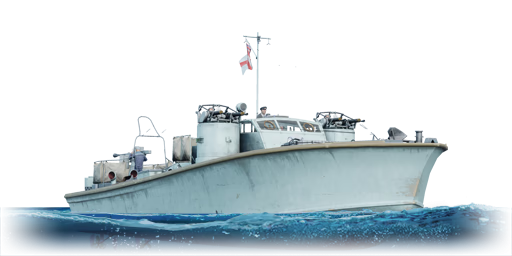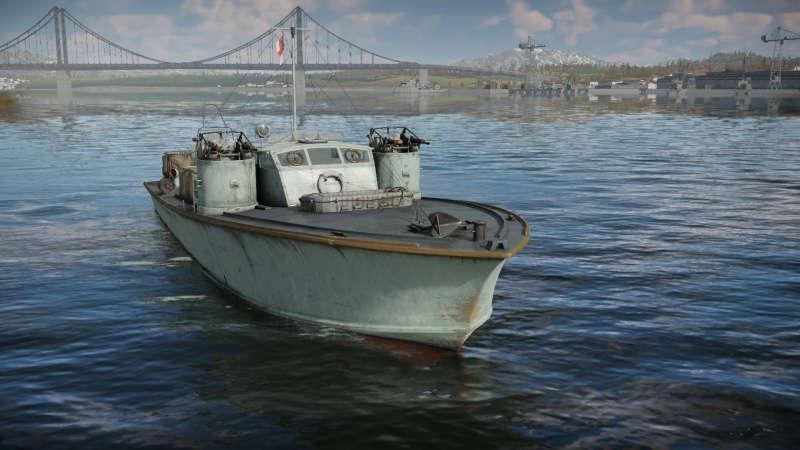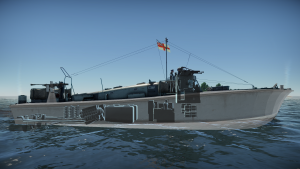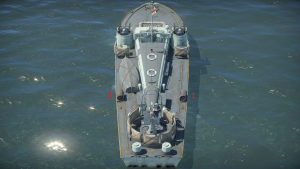MGB-61
Contents
Description
The 70 ft MGB-61 is a rank I British motor gun boat with a battle rating of 1.7 (AB/RB/SB). It was introduced in Update 1.83 "Masters of the Sea" as part of the British fleet closed beta test. With the split of the naval tech trees in Update "New Power", MGB-61 was moved to the coastal fleet tech tree.
General info
Survivability and armour
MGB-61 has the following armour layout:
- 40 mm 2pdr Rolls Royce gun shield: 12.7 mm hardened armour
- Hull: 40 mm, wood
- Superstructure: 15 mm, wood
Like most coastal vessels, MGB-61 has no practical armour. The gunshields are largely superficial; while they may stop low-calibre machine guns, heavy machine guns and cannons will easily penetrate them at any range. The hull and superstructure are unarmoured and will not stop any sort of gunfire.
The hull is split into three compartments. Starting from the bow and working towards the stern, the first compartment starts at the bow and ends in front of the bridge; the second ends between the fuel tanks and the engines; the third ends at the stern.
MGB-61 can be hull-broken by any round with a large enough diameter and explosive mass. In general, this is limited to HE rounds greater with a diameter greater than or equal to 4 inches (102 mm) with an explosive mass greater than 1.5 kg. At MGB-61's own battle rating, there is only one gun capable of hull-breaking her:
- the 114 mm 8cwt QF Mk I, found on Dark Adventurer.
There are two ammunition storages: the first, holding the ammunition for the primary armament, is located just above the waterline in front of the aft 40 mm 2pdr Rolls Royce cannon; the other ammunition storage, holding the ammunition for the secondary armament, is located just above the waterline directly underneath each of the two twin 12.7 mm Vickers Mk.V machine gun mounts. Destroying either will instantly destroy MGB-61.
MGB-61 has a crew complement of 12. With a stock crew, it is knocked out when 7 crew are lost; with an aced crew, this is increased to 8. Overall, the survivability is average.
Mobility
| Mobility Characteristics | |||||
|---|---|---|---|---|---|
| Game Mode | Upgrade Status | Maximum Speed (km/h) | Turn Time (s) | Turn Radius (m) | |
| Forward | Reverse | ||||
| AB | Stock | 73 | 20 | ~23.21 | ~42.07 |
| Upgraded | 99 | 27 | ~15.41 | ~26.57 | |
| RB/SB | Stock | 64 | 17 | ~25.64 | ~47.61 |
| Upgraded | 74 | 20 | ~21.18 | ~38.39 | |
MGB-61 has a displacement of 34 tons.
When moving forwards at high speeds, the bow will lift out of the water. This creates a blind spot at close ranges in front of the boat where, depending on the angle, one or both of the twin 12.7 mm Vickers Mk.V mounts are unable to depress far enough to get the guns on target.
Modifications and economy
The recommended modification research order is:
- Tool Set
- Fire Protection System
- 12.7 mm I
- Smokescreen
- 40 mm AP
- Rudder Replacement
- Improved Rangefinder
- Artillery
After that, research the rest of the seakeeping modifications, followed by the rest of the modifications in whatever order you prefer.
Armament
Primary armament
The primary armament consists of four 12.7 mm Vickers Mk.V machine guns in two twin mounts, one on either side of the bridge. There are 4,000 rounds of ammunition available for each mount, 2,000 rounds per gun, for a total of 8,000 rounds. Stock, the mounts can traverse horizontally and vertically at a rate of 64°/s; with the "Primary Armament Targeting" modification installed, this is increased to 75°/s. Each gun has a belt capacity of 200 rounds and a cyclic rate of fire of around 600 rounds/min, though the outboard guns on both mounts fire slightly faster, around 685 rounds/min. With a stock crew, the guns can be reloaded in 13 seconds; with an aced crew, they can be reloaded in 10 seconds.
| Turrets are named sequentially, clockwise, starting at the bow |
| Primary armament guidance | |||||||
|---|---|---|---|---|---|---|---|
| No.1 Turret (starboard) | No.2 Turret (port) | ||||||
| Horizontal | Vertical | Horizontal | Vertical | ||||
| ±180° | -10°/+70° | ±180° | -10°/+70° | ||||
There are three ammunition choices available:
- Universal: T · AP · I
- 12.7 mm I: T · I · I · I · I
- 12.7 mm API: T · AP · I · AP
| Penetration statistics (belt) | ||||||
|---|---|---|---|---|---|---|
| Belt | Penetration @ 0° Angle of Attack (mm) | |||||
| 10 m | 100 m | 500 m | 1,000 m | 1,500 m | 2,000 m | |
| Universal | 24 | 24 | 21 | 18 | 16 | 15 |
| 12.7 mm I | 20 | 19 | 16 | 14 | 12 | 11 |
| 12.7 mm API | 24 | 24 | 21 | 18 | 16 | 15 |
| Penetration statistics (shell) | |||||||
|---|---|---|---|---|---|---|---|
| Ammunition | Type of warhead |
Penetration @ 0° Angle of Attack (mm) | |||||
| 10 m | 100 m | 500 m | 1,000 m | 1,500 m | 2,000 m | ||
| T | T | 20 | 19 | 16 | 14 | 12 | 11 |
| AP | AP | 24 | 24 | 21 | 18 | 16 | 15 |
| I | I | 3 | 2 | 2 | 2 | 2 | 2 |
| Shell details | |||||||||
|---|---|---|---|---|---|---|---|---|---|
| Ammunition | Type of warhead |
Velocity (m/s) |
Projectile Mass (kg) |
Fuse delay (m) |
Fuse sensitivity (mm) |
Explosive Mass (TNT equivalent) (g) |
Ricochet | ||
| 0% | 50% | 100% | |||||||
| T | T | 753 | 0.04 | N/A | N/A | N/A | 47° | 56° | 65° |
| AP | AP | 753 | 0.05 | N/A | N/A | N/A | 47° | 56° | 65° |
| I | I | 753 | 0.04 | N/A | 0.1 | 1.8 | 47° | 56° | 65° |
Of the belts, the I belt has a noticeably higher damage output than both the Universal and API belts, both of which are about the same in terms of damage. This is because it has the highest concentration of incendiary rounds, which are the only ones with any high-explosive filler. However, because it lacks any armour-piercing rounds, the I belt has slightly less armour penetration than the other two belts. In general, though, any armour that can stop the incendiary round will also be able to stop the armour-piercing round. For the most effectiveness, take only the I belt once unlocked, and switch the primary 20 mm/70 Oerlikon Mk.II cannon to deal with armoured targets.
Secondary armament
The secondary armament consists of a single 40 mm 2pdr Rolls Royce cannon mounted aft, with a maximum of 1,200 rounds of ammunition. Stock, the mount can traverse horizontally at a rate of 38°/s and vertically at a rate of 47°/s; with the "Auxiliary Armament Targeting" modification installed, this is increased to 45°/s and 55°/s respectively. The gun has a magazine capacity of 4 rounds and a cyclic rate of fire of 231 rounds/min. With a stock crew, the gun can be reloaded in 2.21 seconds; with an aced crew, it can be reloaded in 1.7 seconds.
| Secondary armament guidance | |
|---|---|
| Horizontal | Vertical |
| ±151° | -12°/+60° |
There are three ammunition choices available:
- Universal: HEF · AP-T · HEF · AP-T
- 40 mm HE: HEF · HEF · HEF · AP-T
- 40 mm AP: AP-T · AP-T · AP-T · HEF
| Penetration statistics (belt) | ||||||
|---|---|---|---|---|---|---|
| Belt | Penetration @ 0° Angle of Attack (mm) | |||||
| 10 m | 100 m | 500 m | 1,000 m | 1,500 m | 2,000 m | |
| Universal | 60 | 57 | 50 | 43 | 38 | 34 |
| 40 mm HE | 60 | 57 | 50 | 43 | 38 | 34 |
| 40 mm AP | 60 | 57 | 50 | 43 | 38 | 34 |
| Penetration statistics (shell) | |||||||
|---|---|---|---|---|---|---|---|
| Ammunition | Type of warhead |
Penetration @ 0° Angle of Attack (mm) | |||||
| 10 m | 100 m | 500 m | 1,000 m | 1,500 m | 2,000 m | ||
| AP-T | AP-T | 60 | 57 | 50 | 43 | 38 | 34 |
| HEF | HEF | 3 | 3 | 3 | 3 | 3 | 3 |
| Shell details | |||||||||
|---|---|---|---|---|---|---|---|---|---|
| Ammunition | Type of warhead |
Velocity (m/s) |
Projectile Mass (kg) |
Fuse delay (m) |
Fuse sensitivity (mm) |
Explosive Mass (TNT equivalent) (g) |
Ricochet | ||
| 0% | 50% | 100% | |||||||
| AP-T | AP-T | 701 | 0.91 | N/A | N/A | N/A | 47° | 60° | 65° |
| HEF | HEF | 701 | 0.82 | 0 | 0.1 | 71 | 79° | 80° | 81° |
The best ammunition for general use is the HE belt, due to it having the highest ratio of HE rounds to AP rounds, making it the most effective against both aircraft and the vast majority of surface targets. Because of this, the HE belt should be the main ammunition once it is unlocked. Additionally, take a substantial amount of the belt as well for use against armoured targets. Alternatively, take only Universal if you want to avoid the reload delay between switching ammunition types, though this comes at the cost of lesser damage efficiency.
Additional armament
MGB-61 has two possible loadouts:
- 2x Mk.VII depth charge
- Without load
Depth Charges
The Mk.VII depth charges are carried amidships in front of the aft gun, one on each side. They are dropped one at a time in the following order:
- Starboard
- Port
Before spawning, the detonation time delay can be set anywhere between 3 seconds and 10 seconds.
| Depth charge characteristics | ||||||
|---|---|---|---|---|---|---|
| Mass (kg) | Explosive type | Explosive mass (kg) | TNT equivalent (kg) | HE armour penetration (mm) | Armoured vehicle destruction radius (m) | Fragment dispersion radius (m) |
| 196 | TNT | 130 | 130 | 101 | 8 | 122 |
There is almost no practical reason to use depth charges on any naval vessel in the game. Although they usually result in a one-hit kill if used properly, they are extremely situational, requiring the player to close to point-blank ranges to even use them. In almost every case, anytime a depth charge could be used, the guns or torpedoes can be used instead to greater effect. In fact, depth charges tend to actually be a liability in battle, since they essentially act as exposed ammo racks before they're dropped. They can be shot at, and if destroyed, they have a chance to detonate, instantly destroying the boat.
Despite this, some success can be had in dropping them either next to, or in front of a large, slow target. If dropping them next to the target, remember the depth charge drop order, since it's most likely that only the depth charges dropped on the side closest to the enemy will deal any damage. If dropping in front of the target, rush in from the sides as quickly as possible and drop them all at once directly in front of the target. For both cases, set the depth charge time delay to the minimum 3 seconds, since any higher time delay will only allow the depth charge to sink further away from the target, giving them more time to move out of the way. Again, using depth charges is extremely situational, and they will only be a liability the vast majority of the time, so take them at your own discretion.
Usage in battles
As a motor gun boat, MGB-61's primary armament is actually quite good, unlike the previous vessels in its tech tree line. With four 12.7 mm Vickers Mk.V machine guns, the damage output is roughly comparable to two or three 20 mm cannons, and with a belt capacity of 200 rounds each, they can sustain fire for much longer than most contemporary autocannons. While most of her cannon-armed counterparts must reload after one or two kills, MGB-61 can easily take out multiple enemies in quick succession, making her well suited for aggressive playstyles. However, this firepower comes at the cost of a long reload, anywhere between 13 and 10 seconds depending on the level of the crew.
In addition to a long reload, the primary armament's firing arcs are also somewhat restrictive. Both gun mounts are unable to fire in a ~117° arc in the direction of the other mount, and at rest, both are unable to fire at anything within ~275 m directly behind the boat. When on the move, the bow will lift out the water, eliminating the rear blind spot, but also creating a new one in front of the boat that extends for several hundred meters where one or both of the mounts are unable to depress far enough to get guns on target.
With all of this in mind, play MGB-61 aggressively, but always be aware of the limits of the guns. Because of the long reload, be proactive with the reloads. Keep an eye on the ammunition counter and be sure to fire off any remaining ammo after engagements if there isn't much left in the belts, retreating to do so if necessary. A good time to start doing so is when there are around 250 rounds or less between all four guns. Additionally, because of the poor firing arcs, keep enemies either directly in front or directly behind you at all times so that all of the guns are able to fire, and be ready to speed up or slow down to eliminate the fore or aft blindspots as needed. MGB-61's survivability is rather average and is largely reliant on being able to destroy opponents before they can deal much damage in return, so not being able to fire for even just for a few seconds due to any reason will often result in your own destruction, especially while playing aggressively.
Lastly, if you come across any armoured targets that the 12.7 mm machine guns fail to penetrate — in particular, the Pr.1124 early, Pr.1124 late, and Pr.191 — switch to the secondary 40 mm 2pdr Rolls Royce cannon. This gun is more than capable of punching through any armour MGB-61 might come across, and it also has a higher effective range, making it useful for long-range engagements. However, its damage output is noticeably lower than the four machine guns, so only switch to it when required, but always be ready to do so on a moment's notice.
Pros and cons
Pros:
- Primary armament: high rate of fire, large belt capacity, and good damage output
- Secondary armament: very quick reload, high penetration with AP rounds, and good firing arcs
- Good mobility
Cons:
- Blind spot directly in front while moving at high speeds
- Primary armament: long reload and poor firing arcs
- Secondary armament: cannot fire directly forwards, small magazine capacity, and cannot rotate 360°
History
Over the course of the Second World War, British Power Boat Company (BPB), based at Hythe, manufactured three motor anti-submarine boat (MASB) designs — all three essentially being scaled-up versions of the same overall design — as follows: a 60-foot version, consisting of MASBs 1-5; a 63-foot version, consisting of MASBs 22-45; and a 70-foot version, consisting of MASBs 6-21, 46, and 50-67. These boats were originally designed as motor torpedo boats (MTBs), but with the increasing threat of German U-Boats, those ordered by the Royal Navy were ordered instead as MASBs, their torpedo tubes replaced with depth charge racks and ASDIC equipment.
The 70-foot boats, in particular, had a standard displacement of around 30 tons, with a full displacement of up to 38 tons, depending on the boat. They had a length of 70 ft (21.3 m), a beam of 16 ft 7 in (5.05 m), and a draught of around 3 ft (~1 m) depending on the boat. They were powered as follows:
- MASBs 6-21: Ordered by the Royal Navy as MASBs, all were completed throughout 1940 and 1941. These were originally planned to be powered by Rolls Royce engines. However, these engines eventually became reserved only for Hurricane and Spitfire fighter aircraft by the time the boats were built. Instead, they were powered by two weaker Napier Sea Lion engines and could only achieve 23 knots. In 1942, they received stronger Packard engines, increasing their top speed to 38 knots.
- MASB 46: Originally ordered by the Royal Netherlands Navy as an MTB, with the capitulation of the Netherlands before her completion in May 1940, she was requisitioned by the Royal Navy in July 1940 and completed as a MASB on 13th July 1941. MASB 46 was powered by three Rolls Royce petrol engines and could achieve a top speed of 42.5 knots.
- MASBs 50-67: Originally ordered by the French Navy as MTBs, with the capitulation of France before the completion of most of the order in June 1940, they were requisitioned by the Royal Navy in July 1940 and completed as a MASB throughout 1940 and 1941. MASBs 50-67 were powered by three Isotta-Fraschini engines and could achieve a top speed of 40 knots.
Around 1941, to counter the more heavily armed German E-Boats, the Royal Navy converted most of their MASBs, including all of the BPB 70-foot MASBs, into motor gun boats (MGBs). During this time, the BPB 70-foot boats were redesignated MGBs 6-21, 46, and 50-67 and were all refitted with a standardized armament consisting of 2-pdr aft gun and a twin .50 calibre machine gun mount on either side of the bridge.
MASB-61 was one of the ex-French BPB 70-foot boats. She was completed on 12th April 1941, but with the capitulation of France, she was requisitioned by the Royal Navy in July 1940 and converted into a MASB. In January 1941, she was refitted as a motor gun boat and redesignated as MGB-61. MGB-61 was commanded by the following:
- Lt. P.N. Howes, RN: December 1940 to August 1941
- Lt. I.R. Griffiths, RN: August 1941 to December 1941
- T/Lt. D.P. James, RNVR: December 1941 to July 1942
- T/Lt. J. Collins, RNVR: July 1942 to August 1943
MGB-61 served as part of the 6th MGB Flotilla with HMS Beehive at Felixstowe from 1941 to 1943. She was disposed of in February 1945.
Media
- Skins
See also
External links
- [Coastal Forces Veterans] Boat Database
- [Unit Histories] Royal Navy Coastal Forces 1940-1945
- [naval-history.net] British vessels lost at sea in World War 2 - MGB, MTB, SGB, ML, etc - originally published in British Vessels Lost at Sea, 1935-45, His Majesty's Stationary Office, 1947
- [NAVYPEDIA] MGB6 motor gun boats (35, 1939 - 1941)
- [uboat.net] BPB 70 feet-type (ex: French) class
- [D-Day Revisited] MASB 27 Restoration
- [yalumba.co.uk] British Power Boat Co Page 4
- [Coastal Forces Heritage Trust] Boats
Bibliography
- Konstam, Angus (2010). British Motor Gun Boat 1939–45. Osprey Publishing Ltd. ISBN 978-1-84908-077-4.
| British Power Boat Company | |
|---|---|
| Motor Torpedo Boat (MTB) | |
| 60 ft British Power Boat MTB | MTB-1(1) · MTB-1(2) |
| Motor Gun Boat (MGB) | |
| 70 ft British Power Boat MGB | MGB-61 |
| 71 ft British Power Boat MGB | MGB-75 |
| Britain boats | |
|---|---|
| Motor torpedo boats | Brave Borderer · Dark Aggressor · Dark Aggressor TD · Fairmile D (617) · Fairmile D (697) · Fairmile D (5001) · HMS Gay Archer |
| MTB-1(1) · MTB-1(2) · MTB Vosper · MTB Vosper(2) · MTB-422 | |
| Motor gun boats | Dark Adventurer · Fairmile A (ML100) · Fairmile B (ML345) · Fairmile C (312) · Fairmile C (332) · Fairmile D (601) · Fairmile H LCS(L)(2) |
| HMAS Arrow · HMAS Fremantle · MGB-61 · MGB-75 · ML 1383 · SGB Grey Fox · SGB Grey Goose | |
| Gunboats | HMS Spey |







